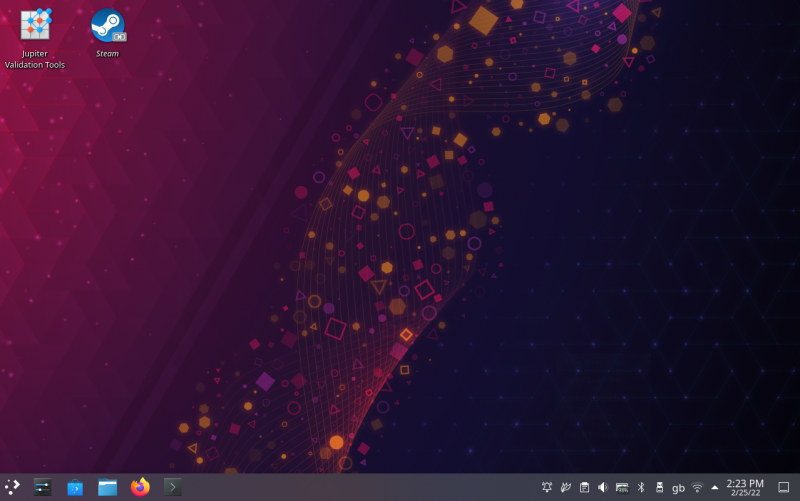SteamOS is a Linux distribution developed by Valve, based on Arch Linux. It serves as the operating system for the Steam Deck and was also used for Steam Machines. It integrates Valve's Steam storefront, providing a platform for gaming.
September 16, 2013: Gabe Newell's LinuxCon Announcement
On September 16, 2013, at LinuxCon, Valve co-founder Gabe Newell stated his belief that "Linux and open source are the future of gaming" and mentioned aiding game developers to make games compatible with Linux.
September 20, 2013: Steam Universe Expansion Teaser
On September 20, 2013, Valve teased three new announcements related to expanding the Steam Universe in 2014 to provide more ways for customers to access Steam in the living room.
October 2013: Steam Dev Days and Nvidia Collaboration Announcement
In October 2013, Valve announced Steam Dev Days, a conference for developers to test and provide feedback on SteamOS and Steam Machines. Also in October 2013, Nvidia announced its collaboration with Valve to support SteamOS with Nvidia GameWorks.
November 2013: Valve's Stance on SteamOS Exclusives
In November 2013, Valve confirmed they would not be making any exclusive games for SteamOS and discouraged other developers from doing so.
December 13, 2013: SteamOS 1.0 Beta Release
On December 13, 2013, Valve released a beta version of SteamOS (SteamOS 1.0). Valve advised users unfamiliar with Linux to wait for SteamOS 2.0 in 2014.
2013: SteamOS 1.0 Release
In 2013, SteamOS version 1.0 was released, based on the Debian distribution of Linux with GNOME desktop. The intent was for lightweight, upgradeable PCs, known as Steam Machines, to run SteamOS for game streaming and local play.
January 2014: GameSpot SteamOS 1.0 Beta Performance Comparison
In January 2014, GameSpot compared the performance of Dota 2, Left 4 Dead 2, and Metro: Last Light on Windows 7 x64 and SteamOS 1.0 beta. They observed lower frame rates on SteamOS with an AMD graphics card and driver issues, while Metro: Last Light ran slightly better on SteamOS with an Nvidia card.
2014: Steam Universe Expansion Teaser
In 2014 Valve teased three new announcements related to expanding the Steam Universe to provide more ways for customers to access Steam in the living room.
2014: SteamOS 2.0 Release Date Recommendation
In 2014, Valve recommended users unfamiliar with Linux to wait for the release of SteamOS 2.0.
October 2015: Netflix Support added to SteamOS
In October 2015, an update allowed Netflix and other DRM protected content to function in the native built-in browser. SteamOS 2.0 installations recommended an Intel or AMD 64-bit capable processor, at least 4 gigabytes of RAM, 200 GB on one's hard disk, either an AMD Radeon 8500 or newer or an Nvidia Fermi graphics card (GeForce 400 series and GeForce 500 series) or newer, a USB port and UEFI boot support.
October 2015: Steam Controller, Steam Link, and Alienware Steam Machines Preorders
In mid-October 2015, preorders of the Steam Controller, Steam Link, and Alienware branded Steam Machines became available.
November 10, 2015: Steam Machines Official Release
November 10, 2015, marked the official release date for Steam Machines.
November 2015: Ars Technica SteamOS 2 vs Windows 10 Performance Comparison
In November 2015, Ars Technica compared the rendering performance of cross-platform games on SteamOS 2 and Windows 10, finding that games rendered between 21% and 58% slower on SteamOS 2. The article suggested that developer inexperience with OpenGL optimization may be a factor.
2015: Falcon Northwest and Origin PC's Decision on SteamOS
In 2015, Falcon Northwest and Origin PC opted not to ship SteamOS-enabled machines due to limitations compared to Windows. Falcon Northwest expressed potential future interest if performance improves.
2015: SteamOS 2.0 Release
In 2015, SteamOS version 2.0 was released, also based on the Debian distribution of Linux with GNOME desktop. Valve encouraged developers to incorporate Linux compatibility into their releases to better support Linux gaming options, including SteamOS.
July 15, 2021: Steam Deck and SteamOS 3.0 Announcement
On July 15, 2021, Valve announced the Steam Deck, a handheld PC gaming device, which would run a new version of SteamOS, version 3.0. This version is based upon Arch Linux with the KDE Plasma 5 desktop environment pre-installed.
February 2022: Steam Deck Release with SteamOS 3.0
In February 2022, Valve released the Steam Deck gaming handheld, running SteamOS version 3.0, based on Arch Linux with the KDE Plasma desktop environment pre-installed, as well as Valve's Proton compatibility layer.
March 2022: Linus Tech Tips SteamOS 3.0 vs Windows 10 Performance
In March 2022, Linus Tech Tips compared SteamOS 3.0 and Windows 10 performance on the Steam Deck using gaming benchmarks like Hitman 3, Doom Eternal, and Elden Ring, showing higher average frames per second on SteamOS.
December 2024: SteamOS Brand Guidelines Released
In December 2024, Valve released brand guidelines for SteamOS to be used by other manufacturers to indicate support for the operating system.
January 2025: Lenovo Legion Go S Release
In January 2025, Lenovo released the Legion Go S, which was the first official third-party handheld device that could be operating using SteamOS.
April 2025: SteamOS Version for Any Handheld Computer
Valve anticipates releasing a version of SteamOS that can be installed on any handheld computer by April 2025.
May 2025: SteamOS Support for Lenovo Legion Go S
In May 2025, Valve released an update to SteamOS to formally support the Lenovo Legion Go S.
May 2025: SteamOS Beta Release Intended
SteamOS Beta for handheld is intended to be released before Lenovo's Legion Go S releases in May 2025.
Mentioned in this timeline

Nvidia is a multinational technology company specializing in GPUs APIs...

The Steam Deck a handheld gaming computer by Valve allows...

Intel Corporation is a multinational technology company headquartered in Santa...

Falcons are birds of prey belonging to the genus Falco...
Advanced Micro Devices AMD is a multinational technology corporation specializing...

September is the ninth month of the year in the...
Trending

23 days ago James Gunn Plans Superman Sequel Shooting Soon; Teases 'Peacemaker' Role in DCU.
23 days ago Motorcycle crash in Beloit on Cranston Road: Police investigate single-vehicle incident.

23 days ago Zion: Influencers' Storm, Hidden Trail & East Mesa Hike, Views and Fewer Crowds
23 days ago Qatar Airways and Accenture partner for AI-driven aviation excellence, creating 'AI Skyways'.

23 days ago Ketel Marte's Absence and Day Off Requests Cause Frustration Among Diamondbacks Teammates

23 days ago Jamie Lee Curtis Celebrates 'Freakier Friday' with Fan Event and Lookalike Screening
Popular

Carlo Acutis was a British-born teenager of Italian ancestry deeply...

Paracetamol also known as acetaminophen is a commonly used over-the-counter...

Bill Clinton the nd U S President - served as...

Robert F Kennedy Jr an American politician environmental lawyer author...

Aryna Sabalenka is a highly accomplished Belarusian professional tennis player...

Bernard Sanders is a prominent American politician serving as the...



